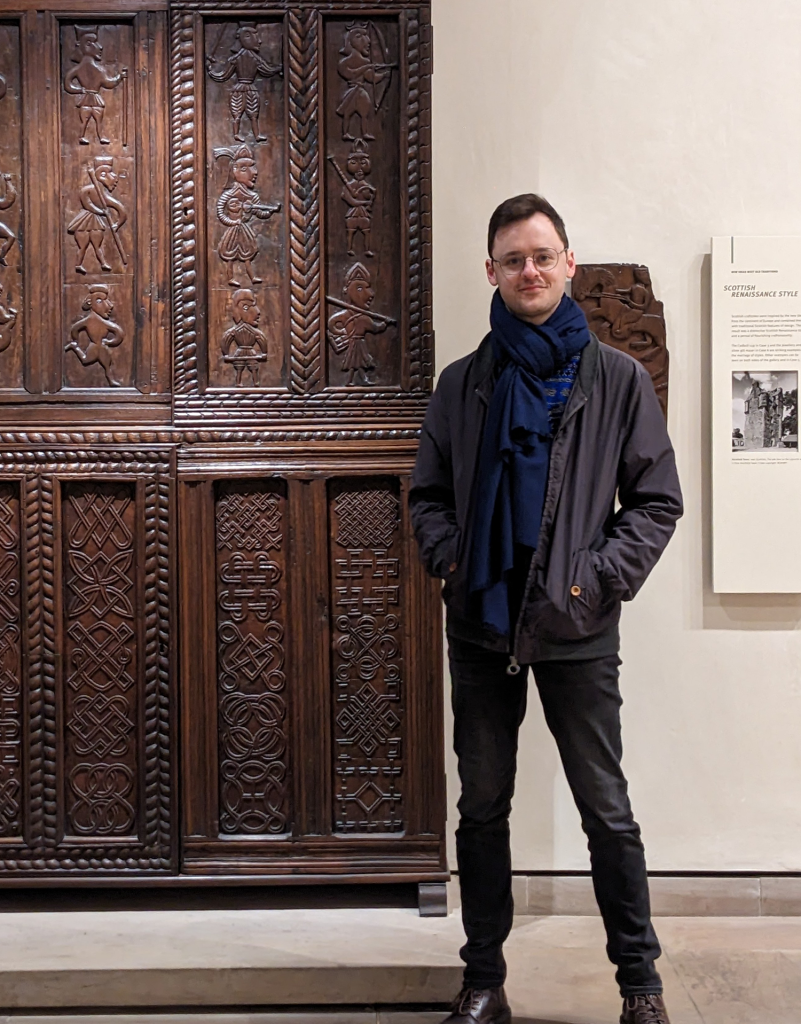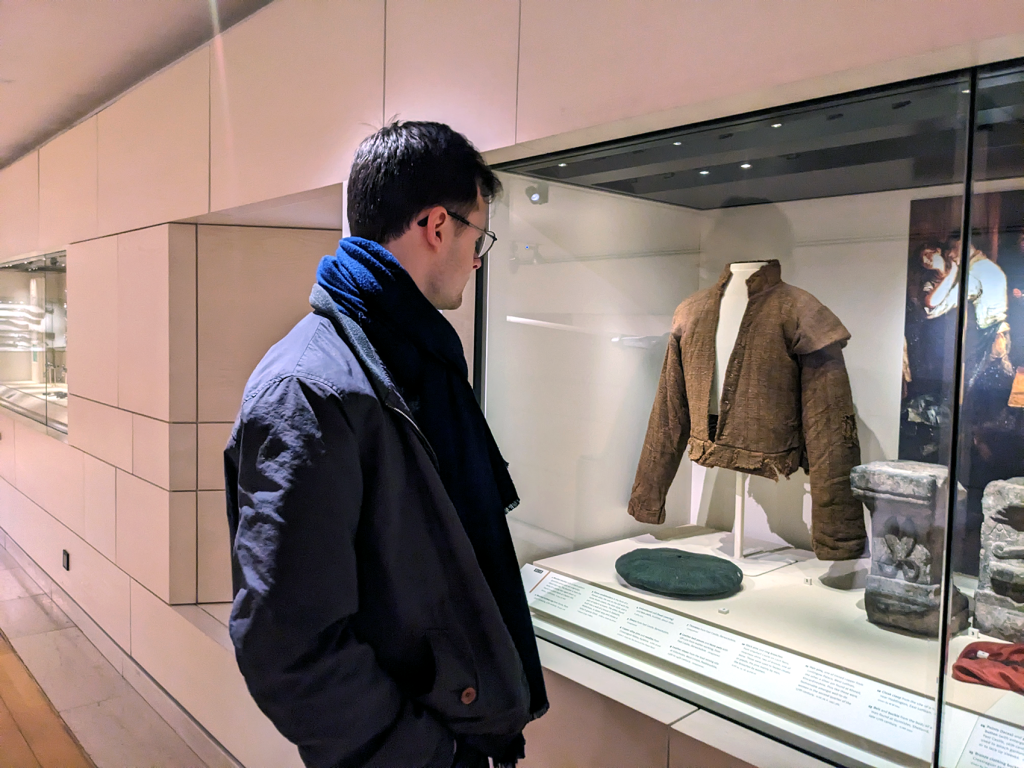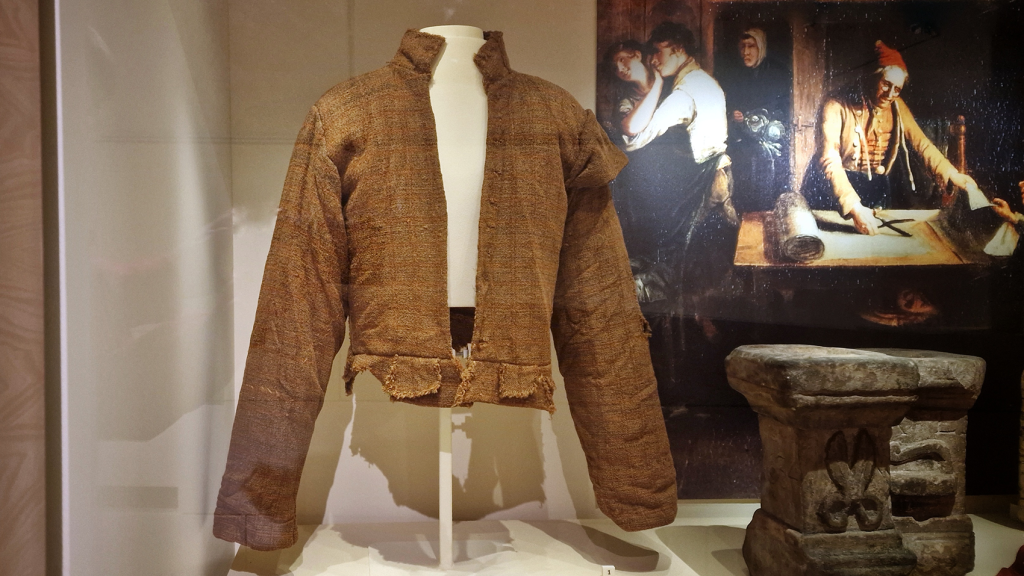In our Orientations series, members of the LGBTQIA+ community explore an object that resonates with their identity. We know our collections are filled with queer stories but often they can be hard to find (and even harder to prove). In looking for representation in museums, Joe Setch explores how the apparent absence of these stories can allow our imaginations to touch on queer histories in a different way.
Queer people are everywhere, and always have been. But it’s only in recent decades that we’ve been able to push our way into the mainstream of Scottish society.
For most of Scotland’s history, as was the case across much of Europe, queer perspectives were expressed through double meanings and deniability. Threatened with persecution, we took care to leave little trace. We existed: but only in the moment.
When historical records acknowledge the existence of LGBTQIA+ Scots (and they rarely do), they portray us as sick, sinful, corrupting, and criminal. Inhabiting a straight society, we were an ‘other’ to be pitied and feared.
This poses a challenge for modern museums. How can they celebrate the history of queerness when its stories were so often hidden or held in contempt? How can they explore identities which only recently found the words to describe themselves? Concrete facts are hard to find, and there aren’t many objects which we can put on display.
When queer history survives, it’s often shared in silence. At the National Museum of Scotland, entire chapters of Scottish history come and go without any mention of LGBTQIA+ life. We’ve always existed, but you wouldn’t know it at first glance.

So, let’s take another look. After all, silence shouldn’t be mistaken for absence. New research and new sources are revealing the LGBTQIA+ stories hidden within museum objects. With each new discovery, we move towards a more accurate and inclusive understanding of our past.
We can take this process a step further by playing with the remaining gaps in our knowledge. Queer representation can exist almost anywhere in museums: all it takes is a little leap of the imagination.
The National Museum of Scotland displays thousands of objects with labels which start and end at the place they were found. Who made them, used them, held them, wore them? A lot of the time, we simply don’t know. It’s these mysteries which offer us an opportunity to explore Scotland’s history in a different way.
Scotland’s LGBTQIA+ lives are bound up in many of the unrecorded and unknowable aspects of these objects. Was it queer minds that dreamt up the patterns of Pictish stones? Did queer hands carve the Ballachulish figure? The anonymous aspects of these artefacts make them tantalisingly inclusive.
For me, these acts of imagining are at their most powerful when they involve objects from the Highlands. It’s the place where I discovered my own gay identity, and the place I now call home.
I scour display cases for objects from familiar locations and place them in the landscapes I’ve lived in and explored. I imagine how they were used and what they meant to their owners and makers.
The fictions I build as I wander through the museum are rooted in realities of queer life and love in the Highlands. They serve as reminders that people like me have always existed there, just as they have elsewhere.
Other objects bridge the divides of time by telling real stories which speak to my emotions and experiences. When a piece of history connects with my own perspective as a gay Highlander, it strengthens my sense of belonging by reinforcing the possibility of a continuity of queerness.

One item with a powerful personal resonance is a woollen doublet (K.1997.36 A&B), a type of jacket, found near the village of Keiss in Caithness. Displayed in a quiet gallery on Level 2 of the National Museum of Scotland, this frayed and faded garment is easy to overlook. But it tells a compelling story from the margins of life in the Highlands almost 400 years ago.
When this doublet was discovered by peatcutters digging in the hills above Keiss in 1975, their first instinct was to call the police.
It formed part of a grim scene. There under the jacket were the remains of a boy in his late teens. Two large slabs and three smaller stones, placed on top of his body, indicated a deliberate burial. A length of rope suggested a violent cause of death.
The style of the doublet made it possible to date the site to the middle of the 1600s. Preserved under a thick layer of peat, it was the last vestige of an unknown, and possibly criminal, life.

Placed in an unmarked and isolated grave, both the jacket and its owner were meant to be forgotten. But in an ironic twist, the very manner of their burial ensured the survival of their story.
I’m fascinated by this final act of defiance. Could it reflect the teenager’s own relationship with expectations and authority?
Further suggestions of the teenager’s personality can be found in the design of their doublet. There are fashionable flourishes at the shoulders and in the hints of red and green check which push through the peat-stained fabric. This jacket would have stood out from the crowd: was it buried because it was too distinctive to re-purpose?
I’m drawn to the doublet and its owner because it speaks to the complex feelings of otherness, isolation, outspokenness, and uncertainty which coloured my experiences of growing up as a teenager in the Highlands. It brings up memories of solitary walks through forests and moors, searching for the space to ask questions about selfhood and sexuality.
At the time, this landscape felt ill-equipped to accommodate my own sense of differentness. Coming out at the age of 16 was a step into the unknown: I didn’t know where to look for support and wasn’t aware of any examples to follow.
This is why objects like the Caithness doublet have such personal significance. The queer imaginings which I craft from the items on display in the National Museum of Scotland help to reassure me that Scotland and the Highlands are places where I can be and belong. It’s a process that reconciles my identities by charting paths which, although they may be lost to memory, must have once been walked before.
About the author
Joe (he/him) moved down to Edinburgh in 2022 after a quiet few years back home in the Highlands. Joe now works as a marketing and communications officer for Museums Galleries Scotland, the national development body for museums.
Writing this article was a great way for Joe to revisit stories which he first encountered while working in the front-of-house team at National Museums Scotland way back in 2016.
_________________________________________________________________________
LGBTQIA+ stories have often been left out of mainstream history and we are keen to make them more visible through stories told by our objects, LGBTQIA+ voices in the museum and by bringing in external perspectives. Explore the stories so far.
And if you want to help us tell these stories, send us a pitch!
